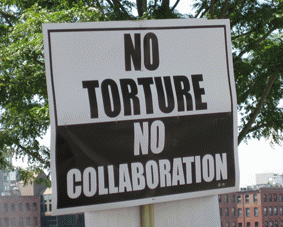In Mary Shelley's Frankenstein, written nearly 200 years ago, a young scientist brings to life a hideous monster made of body parts collected from slaughterhouses, dissecting rooms, and graveyards. Dr. Frankenstein is immediately horrified and sickened by what he has created, and he abandons the creature. Alone and shunned by society, the monster later returns and pleads with the doctor to create a mate for him. The remorseful Dr. Frankenstein hesitantly consents, but he stops his work when moral qualms and fears of unknown consequences intercede. Vengeful and enraged, the monster returns again and murders the doctor's new bride on their wedding night. Dr. Frankenstein vows to spend his remaining years tracking down and killing his grotesque creation, but he himself dies before achieving this final goal.
Sadly, there is no shortage of arenas where the tale of Frankenstein -- of science unmoored from values, of ambition unrestrained by conscience -- resonates powerfully today. One that stands out for many psychologists is the American Psychological Association's (APA) ongoing, decade-long embrace of "war on terror" opportunities that have placed U.S. psychologists at the center of coercive interrogations and other human rights abuses.
After the attacks of 9/11, moral leadership and clarity of ethical convictions were sorely needed -- in the world, in our government and military, and in the profession of psychology. But rather than taking a firm stand in defense of psychological ethics, at key moments APA leaders have chosen to create one monster after another, in the form of policies that support the misuse of psychology by the Department of Defense and the CIA. Into Dr. Frankenstein's laboratory they have gone time and again. The APA's monstrosities are not eight-feet tall and made of discarded body parts. But they are undeniably grotesque, and they are assuredly larger than life when measured by the devastation they have caused. Consider these five examples, in chronological order.
********
Who shall conceive the horrors of my secret toil, as I dabbled among the unhallowed damps of the grave, or tortured the living animal to animate the lifeless clay? My limbs now tremble and my eyes swim with the remembrance; but then a resistless, and almost frantic, impulse urged me forward; I seemed to have lost all soul or sensation but for this one pursuit. (Frankenstein, Chapter 4)
********
Monstrosity I
The APA adopted a revised ethics code in 2002, shortly after the 9/11 attacks. Although the revision process was underway before the Bush administration's "war on terror" had commenced, the APA's leadership was certainly aware of -- and seemingly untroubled by -- Vice President Cheney's ominous warning to a national television audience:
"We also have to work" the dark side, if you will. We've got to spend time in the shadows in the intelligence world. A lot of what needs to be done here will have to be done quietly, without any discussion, using sources and methods that are available to our intelligence agencies".That's the world these folks operate in, and so it's going to be vital for us to use any means at our disposal, basically, to achieve our objective." (Meet the Press, 9/16/01)
With input from psychologists in the fields of national security and intelligence operations, the 2002 APA Ethics Code included two changes welcomed by those who embraced the "dark side." First, changes were made to provide psychologists with the "just following orders" Nuremberg Defense, so that they could claim exemption from professional accountability if "law, regulations, or other governing authority" permitted them to act against the foundational principles of psychological ethics. Second, other changes to the code loosened the ethical requirements surrounding research. Researchers were freed to more readily bypass informed consent from participants, and they were permitted to use deception unless the research would reasonably be expected to cause "physical pain or severe emotional distress." These revisions were the basis for psychologist involvement in gruesome interrogations and odious experiments on detainees. They became abominations that drained much of the ethical lifeblood from the profession of psychology.
********
With an anxiety that almost amounted to agony, I collected the instruments of life around me, that I might infuse a spark of being into the lifeless thing that lay at my feet. It was already one in the morning; the rain pattered dismally against the panes, and my candle was nearly burnt out, when, by the glimmer of the half-extinguished light, I saw the dull yellow eye of the creature open; it breathed hard, and a convulsive motion agitated its limbs. (Frankenstein, Chapter 5)
********
Monstrosity II
Before the APA's ethics code revision had even been officially adopted in the summer of 2002, psychologists were at work creating and unleashing a second monstrosity: a set of grisly detention and interrogation procedures designed to disorient, debilitate, and degrade their prisoners. Relying on the principles of learned helplessness, psychologists were among the foremost developers and purveyors of the torture regimen. Rather than trying to imbue the spark of life -- Dr. Frankenstein's misguided ambition -- "war on terror" psychologists used their laboratories to devise fiendish ways to wrest all dignity and humanity from their unwilling victims: forced nakedness, diapering, hooding and other forms of sensory deprivation, temperature extremes, shackling to ceilings and floors, confinement in dark boxes, intimidation by dogs, sexual humiliation, sensory bombardment, sleep deprivation, exploitation of phobias, death threats, and asphyxiation with the waterboard.
(Note: You can view every article as one long page if you sign up as an Advocate Member, or higher).






